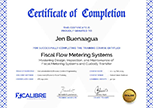| Date | Venue | Fee | |
|---|---|---|---|
| 06 Apr - 10 Apr 2026 | Cairo - Egypt | $ 5,950 | Register Now |
| 08 Jun - 12 Jun 2026 | Dubai – UAE | $ 5,950 | Register Now |
| 21 Sep - 25 Sep 2026 | Dubai – UAE | $ 5,950 | Register Now |
| 14 Dec - 18 Dec 2026 | Dubai – UAE | $ 5,950 | Register Now |
About the Course
This 5-day interactive Advanced Core and Log Interpretation training course will reflect on collecting and integrating data required for formation evaluation and building a reservoir model. It will discuss the concept of core analysis and how to use the core to calibrate the open hole logs. It will continue to cover the findings and the correct petrophysical parameters for creating mathematical transforms used in constructing 3D static models.
The workflow will also include various methods for estimating shale volume using Gamma-ray different logging tools such as Gamma Ray (basic & spectral), Density, Neutron, Sonic, and resistivity. Also, it will discuss various methods of lithological interpretation using basic and advanced logging tools in integration with drilling cuttings and lab analysis.
Delegates will know the different approaches for estimating porosity and permeability using basic logging tools such as Density, Neutron, and Sonic and advanced logging tools such as nuclear magnetic resonance in integration with core data in case of availability. Different water saturation models (Archie, Indonesia, etc.) will be discussed in addition to how to estimate saturation exponent and its significant effects on estimated water saturation—using the core for rock typing and neural networks.
Core Objectives
The delegates will achieve the following objectives:
- Perform the petrophysical rock types, water saturation, and capillary pressure
- Familiarise with different logging tools in the oil market
- Know how to select the best tools relevant to different reservoirs
- Understand the porosity and permeability models and their impact on reserve and production
- Learn the workflow of the basic formation of fluid saturations and contacts
- Understand the concept of net reservoir and net pay
- Discuss the integration with other disciplines (Geology, Geophysics, Reservoir, and Petroleum Engineering)
- Recognise the different tests to be conducted for the core sample in the lab
- Utilise the Porosity, permeability, and net-to-gross in the modeling
Training Approach
This training course will be conducted through classroom or virtual training in interactive and practical methods. There will be daily individual exercises, and everyone will get an opportunity to discuss their issues with the software or with the concept itself. There will be a PowerPoint Presentation to capture all notes and explain everything in detail, and a daily recap will be provided for maximum benefit for the delegates.
The Attendees
This training course is designed for anyone who wants to understand the theory behind magnetic resonance tools and their applications in formation evaluation.
Likewise, it will be valuable to the professionals but not limited to the following:
- Petrophysicist
- Geologists
- Reservoir Engineers
- Geophysicists
- Petroleum Engineers
- Team Leaders and Everyone involved in Reservoir Characterisation and Reservoir Development
Daily Discussion
DAY ONE: INTRODUCTION TO PETROPHYSICS AND CONVENTIONAL LOGGING TOOLS
- How to get the core from wells and different core types?
- Coring objectives
- Preparing Core Sample
- Different Types of Tests on Core including Water Sample Dean Stark
- Routine Core Analysis (RCA)
- Scale Core Analysis (SCAL)
- Core and Log Integration Workflow Process
- Core and Log Integration Importance
- Fundamentals of Log Analysis
DAY TWO: SHALE VOLUME AND LITHOLOGY INTERPRETATION
- Spectroscopy Logging Tools: ECS “Schlumberger”, GEM “Halliburton”, and FLEX “Baker Hughes”
- Nuclear Magnetic Resonance Logging Tools
- Shale Volume Determination using Different Tools
- Gamma Ray
- Density
- Neutron
- Sonic
- Resistivity
- NMR
- Spectroscopy
- Lithology Determination using Various Logging Tools in Integration with Other Measurements
- Integrating the Logging Tools Outputs with Drilling Cuttings and Lab Analysis
DAY THREE: POROSITY – PERMEABILITY ESTIMATION
- Total/Effective Porosity Estimation and Calibration
- Permeability Estimation and Calibration
- Hydrocarbon Effects On Log Readings
- Rock Types/Flow Units Concept
- Saturation High Function (SHF) of the Core
DAY FOUR: FLUIDS SATURATION, CUTOFFS, AND STOOIP
- Core and Capillary Pressure
- Water Oil Contact from Pressure Point
- Water Saturation Models
- How to select the Cutoff?
- Net Reservoir and Net Pay
- Pressure Testing Tools
- Mobility and the Core Permeability Calibration
DAY FIVE: CASE ANALYSIS OF CORE AND WELL INTEGRATION
- Pore Geometry, Clays, and the Relationship to Water Saturation
- Flow Units and Permeability Prediction
- Permeability Prediction Workshop
- How to use the core in neural network for log prediction such as permeability?
- Example of Integrated Logs with Cores
Certificate Awarded
Upon successful completion of this training course, participants will be awarded a Certificate of Completion from XCalibre Training Centre, acknowledging their accomplishment. This certificate serves as a testament to their dedication to developing their skills and advancing their expertise in their respective fields.


